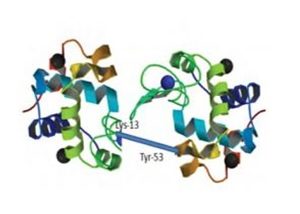 New small N-hydroxysuccinimide (NHS)-aryl azide based heterobifunctional crosslinkers have been used as a ‘proof-of-concept’ to crosslink Lysozyme, in a two-step protocol, involving an initial incubation step followed by photolysis (366 nm, 6W lamp). This was further subjected to SDS-PAGE, excision of the ‘dimeric’ band, trypsin digestion and analyzed by ESI-MS and StavroX 3.6.0.1, a bioinformatics software especially suited for identifying intermolecular crosslinks.
New small N-hydroxysuccinimide (NHS)-aryl azide based heterobifunctional crosslinkers have been used as a ‘proof-of-concept’ to crosslink Lysozyme, in a two-step protocol, involving an initial incubation step followed by photolysis (366 nm, 6W lamp). This was further subjected to SDS-PAGE, excision of the ‘dimeric’ band, trypsin digestion and analyzed by ESI-MS and StavroX 3.6.0.1, a bioinformatics software especially suited for identifying intermolecular crosslinks.
 Unlike the use of Homobifunctional cross-linkers, this two-step procedure provides greater flexibility. Large crosslinkers are more useful for identifying interacting partners, while relatively smaller crosslinkers capture interfaces rather than identities. Our crosslinkers are presumably based on ‘long lived’ transients, the only other parallel being the ones based on fluorinated aryl azides. The new reagents used by us do not involve the difficult and toxic fluorination step, yet parallel the special phenomenon shown by perflourinated reagents. One of these new reagents is based on an “introverted acid”. After feeding FASTA sequence of the protein into the StravroX 3.6.0.1 software and setting the different parameters, a Decoy analysis figure is obtained. The blue bars represent the number of candidates from our data set and the red bars represent the positive false candidates from the inverted sequence of the FASTA file. More enriched real data set candidates indicate towards better crosslinking. In addition, a detailed spectrum showing MS2 identified peaks with their annotation are obtained in a Deviation diagram. Less deviation in the annotation points towards better crosslinking.
Unlike the use of Homobifunctional cross-linkers, this two-step procedure provides greater flexibility. Large crosslinkers are more useful for identifying interacting partners, while relatively smaller crosslinkers capture interfaces rather than identities. Our crosslinkers are presumably based on ‘long lived’ transients, the only other parallel being the ones based on fluorinated aryl azides. The new reagents used by us do not involve the difficult and toxic fluorination step, yet parallel the special phenomenon shown by perflourinated reagents. One of these new reagents is based on an “introverted acid”. After feeding FASTA sequence of the protein into the StravroX 3.6.0.1 software and setting the different parameters, a Decoy analysis figure is obtained. The blue bars represent the number of candidates from our data set and the red bars represent the positive false candidates from the inverted sequence of the FASTA file. More enriched real data set candidates indicate towards better crosslinking. In addition, a detailed spectrum showing MS2 identified peaks with their annotation are obtained in a Deviation diagram. Less deviation in the annotation points towards better crosslinking.
This technique of chemical cross-linking mass spectrometry (CX-MS) has implication in studies of protein-protein interaction and for proteomics/ lipidomics and systems and structural biology. It is also useful for preparing new monoclonal antibody-drug conjugates (ADCs) which specifically target cancer/tumor cells representing “the pinnacle of such targeting efforts”. For obtaining 3D structures,
especially below 3Ǻ, combining CX-MS data with cryo-EM data, using specially developed software (RELION: HADDOCK), allows one to refine structure at almost atomic resolution
For full articles:


